You don’t need a data science team to grow a blog. Many solo writers and tiny teams have scaled traffic, subscribers, and revenue using nothing more than simple analytics, clear goals, and disciplined iteration. Below are real-world style stories (composites distilled from common patterns) that show how small blogs used basic numbers to make smarter bets—and win.
Why simple analytics works for small blogs
- Clarity beats complexity. One or two outcome metrics (e.g., subscribers/week, qualified leads, affiliate revenue) keep you focused.
- Faster feedback loops. When you watch just a few signals—like read time, click-through to a lead magnet, or returning visitors—you can publish, learn, and adjust faster.
- Compounding effects. Tiny lifts to headlines, internal links, and content focus add up when repeated across your top posts.
To make this concrete, here are five short success stories and the metrics that mattered.
Story 1: The niche craft blog that doubled subscribers
Context: A home crafts blog posted weekly tutorials but subscriber growth was flat.
Metrics watched: Top traffic sources, scroll depth, email sign-up click-through rate (CTR).
Insight: 70% of posts with process photos above the fold had >60% scroll depth and 2× higher sign-up CTR. Social traffic from two Facebook groups lingered longer than search visitors.
Moves: Reordered posts so the first screen always showed a striking mid-project image plus a single, relevant CTA (“Get the printable pattern”). Cross-linked high-scroll posts to each other.
Result (90 days): +38% average read time, +92% weekly subscribers, +24% sessions from the two Facebook groups.
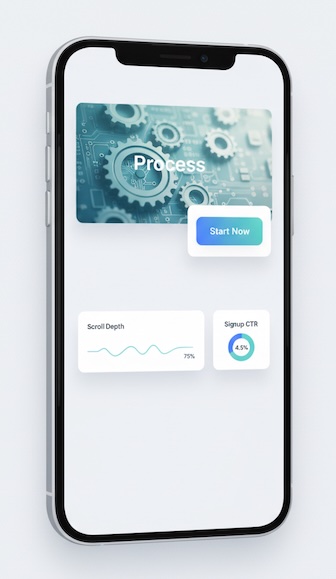
Story 2: The career advice blog that found its money page
Context: A solo blogger wrote about job hunting, productivity, and remote work. Revenue came from a résumé template bundle.
Metrics watched: Outbound clicks to the bundle, exit rate by page, assisted conversions.
Insight: One article—“How to quantify impact on your résumé”—drove 58% of all template clicks, but buried the CTA near the footer.
Moves: Elevated a soft CTA above the first subheader, added a mid-article case vignette with a subtle link, and created two follow-ups that funneled into the same “money page.”
Result (60 days): +130% template clicks, +52% template revenue, with only three edited posts.
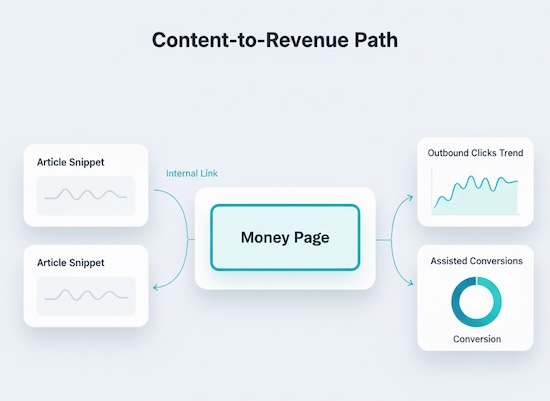
Story 3: The specialty food blog that survived seasonality
Context: Traffic spiked in November–December (holiday recipes) and sagged in spring.
Metrics watched: Seasonal traffic pattern YoY, top internal search queries, returning visitors.
Insight: Internal search surged for “no-bake desserts” and “leftovers” in January when overall traffic dipped. Returning visitors showing those queries had higher newsletter sign-ups.
Moves: Built a “No-Bake January” content cluster; added internal links from holiday posts to leftovers content; placed newsletter CTAs within those clusters.
Result (quarter): Flattened the spring slump: +27% sessions vs. prior year, +41% newsletter sign-ups in Q1.
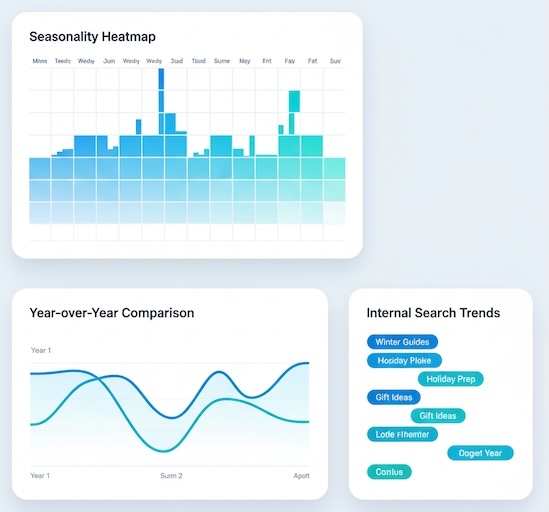
Story 4: The photography blog that fixed bounce without redesign
Context: High bounce on gear reviews; readers landed, skimmed, and left.
Metrics watched: Time to first interaction, internal link CTR, scroll depth by device.
Insight: Mobile readers hit heavy hero images and skipped specs tables below the fold. Posts with “Comparison to X” links near paragraph two kept people longer.
Moves: Compressed hero images, added “Compare with…” links inside intro paragraphs, and put pros/cons bullets before specs tables.
Result (8 weeks): −19% bounce on mobile, +36% internal link CTR, +22% affiliate EPC (earnings per click).
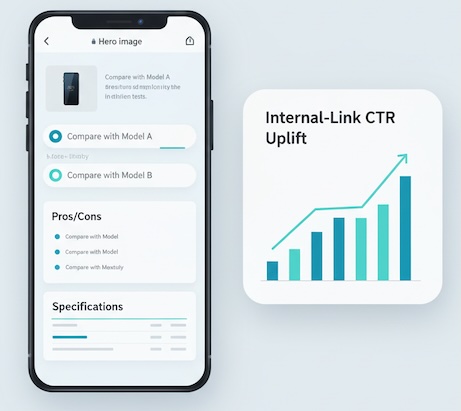
Story 5: The personal finance blog that picked a winning lane
Context: Writer covered budgeting, credit cards, and side hustles; growth stalled.
Metrics watched: New vs. returning visitors by topic, average engaged sessions/post, newsletter replies tagged by topic.
Insight: Side-hustle posts generated fewer sessions but 3× more replies and 2× more returning visitors.
Moves: Narrowed the editorial calendar to side-hustle case studies; created a “Start here” hub and emailed it to new subscribers.
Result (6 months): +58% returning visitors, +44% organic traffic (fewer posts, more depth), sponsor interest for a dedicated series.
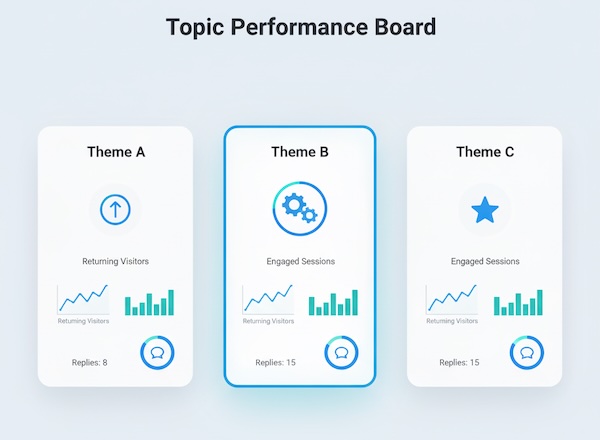
What these stories have in common
- They chose a “north-star” outcome (subscribers, product clicks, revenue) and watched a short list of supporting behavioral metrics (read time, scroll, internal click-through).
- They optimized existing winners—money pages, high-scroll posts, or seasonal clusters—instead of chasing fresh topics every week.
- They used intent signals (internal search, newsletter replies, assisted conversions) to double down on what readers actually wanted.
- They acted with edits, not rebuilds—moving CTAs, tightening intros, repositioning links, and clarifying comparisons.
Snapshot comparison of small-blog wins
| Blog type | One metric that mattered | Small change made | 60–90 day outcome |
|---|---|---|---|
| Crafts | Sign-up CTR above the fold | Lead image + early CTA | +92% subscribers |
| Career | Outbound clicks from “money page” | Mid-article case + higher CTA | +52% product revenue |
| Food | Internal search queries in slow season | “No-Bake January” cluster + links | +27% sessions off-season |
| Photo | Internal link CTR by device | Comparison links in intro | +22% affiliate EPC |
| Finance | Returning visitors by topic | Narrowed to one high-intent lane | +58% returning visitors |
These are directional patterns, not promises. Your baseline and audience will differ—but the levers are repeatable.
The minimalist dashboard for solo bloggers
You don’t need 40 KPIs. Track these five to steer weekly:
- North-star: Subscribers/week, qualified leads/week, or revenue/week.
- Engagement: Median read time or engaged sessions (not just pageviews).
- Discovery: Top traffic sources (focus on the two that grow).
- Intent: Internal search top queries; newsletter replies by topic.
- Momentum: Returning visitors % (or 7-/28-day repeat readers).
If a metric doesn’t influence what you’ll publish or edit next week, drop it from the dashboard.
Patterns worth copying (no tech deep dives required)
- Move value up. Show the most helpful visual, answer, or comparison before the first scroll; place one relevant CTA early, another mid-post.
- Link with intent. Link from high-scroll posts to the page that earns—product, lead magnet, or flagship explainer.
- Name your clusters. Branded series (e.g., “No-Bake January”) make navigation obvious, increase binge behavior, and help partners sponsor.
- Win the second click. Internal clicks are the bridge between attention and outcomes. Write comparison blurbs in the intro to invite that click.
- Listen where it’s loudest. Internal search and inbox replies often beat traffic volume for predicting what to write next.
Common traps small blogs avoid when they grow
- Vanity metrics fixation. Pageviews without read time, or followers without clicks, don’t move outcomes.
- Endless redesigns. Most stories above grew with copy and layout edits, not new themes.
- Topic sprawl. Depth on one pain point beats surface coverage of ten.
- Metrics bingo. A crowded dashboard hides the signal. Keep five, review weekly, adjust monthly.
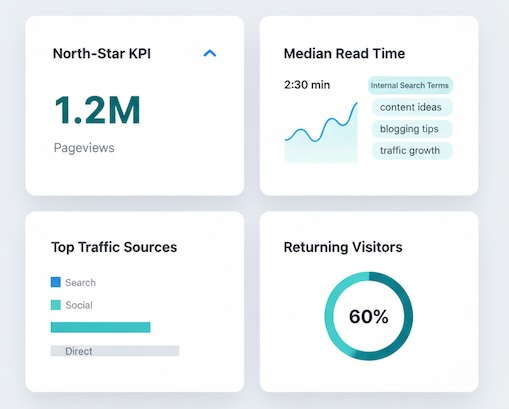
A simple cadence that compounds
- Weekly (30 minutes): Review the five metrics, pick one edit and one post for the next week.
- Monthly (60 minutes): Identify your top 10% posts by outcome metric; improve or extend them.
- Quarterly (90 minutes): Map seasonal patterns and plan one cluster aligned to reader intent during your slowest month.
This isn’t about tools; it’s about rhythm. Small, boring improvements to the right posts, repeated often, make small blogs feel big.

Bottom line
Small blogs get big by aiming analytics at decisions, not dashboards. Choose a north-star outcome, pair it with a few behavioral signals, and edit toward clarity and intent. Move value up, win the second click, and narrow your lane to what readers prove they want. The stories above aren’t outliers—they’re playbooks you can adapt, one focused change at a time.

